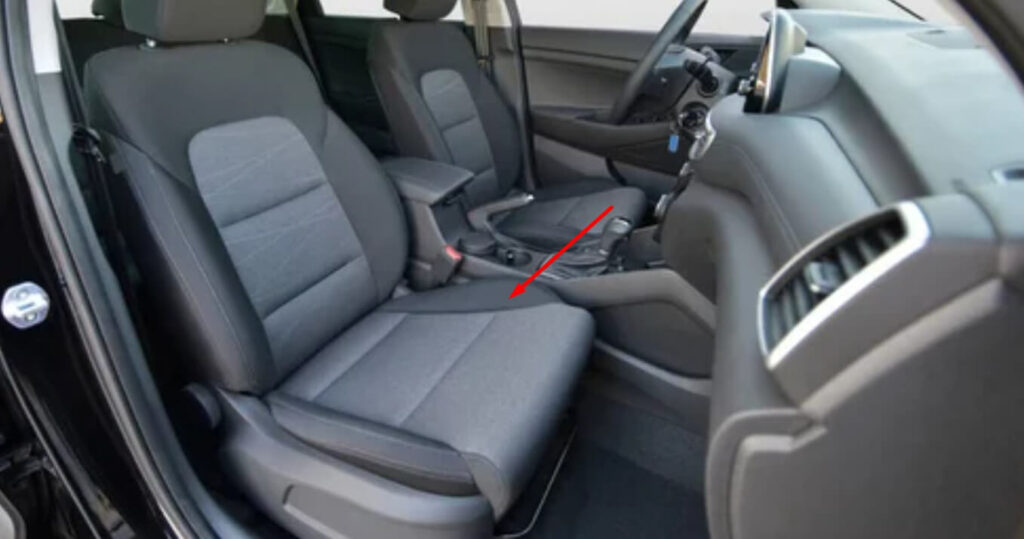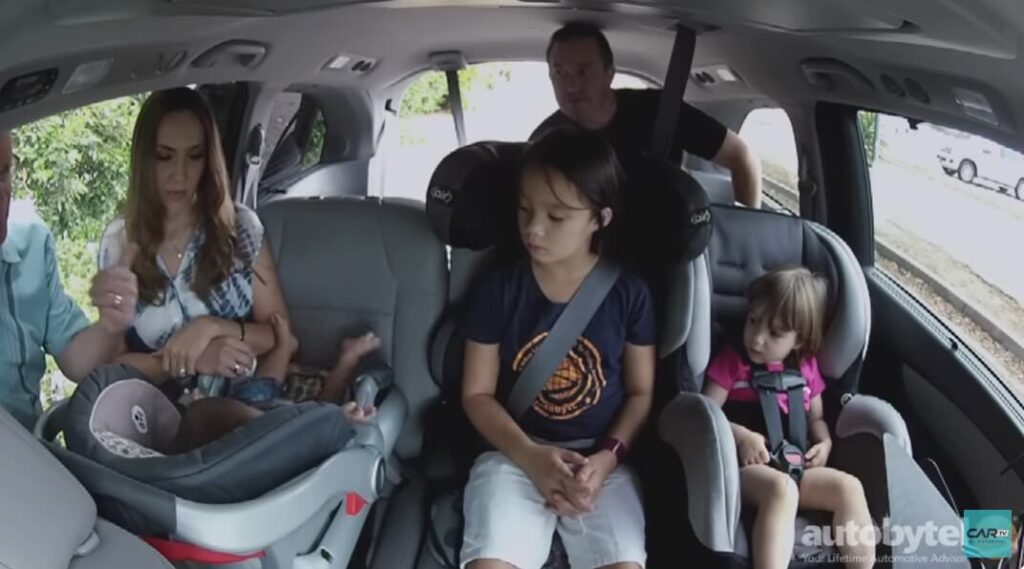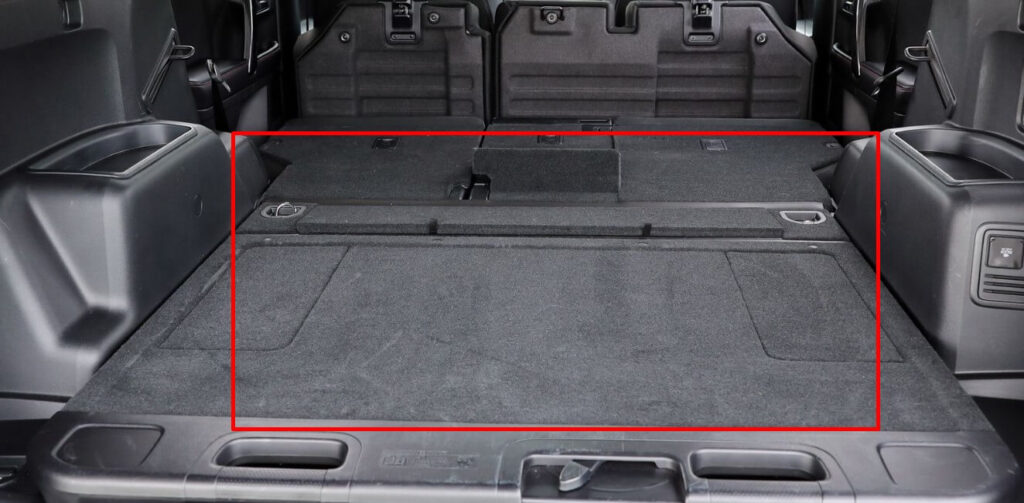The safest place to put a car seat in an SUV is in the back seat, preferably in the middle. This provides the most protection for the child in case of an accident.
As a parent, the safety of your child is always your top priority. Car seat installation is a crucial step in ensuring your child’s safety while traveling. However, the task can be challenging, especially in an SUV. With so many available seats and limited space, it’s easy to get overwhelmed.
The placement of your child’s car seat can significantly impact their safety. Therefore, it’s crucial to understand where to put the car seat in an SUV. In this article, we’ll take a closer look at some helpful tips to help you install your child’s car seat correctly in an SUV.

Best Place For Car Seat In SUV
The best place for a car seat in an SUV is typically in the back seat, either in the middle or on either side. Placing the car seat in the back provides the most protection for the child in the event of a crash and avoids potential airbag-related risks in the front seat.
The middle position is considered the safest as it offers the most distance from side impacts, but using the side seats with proper installation and securing is also safe.
Always follow the car seat manufacturer’s guidelines and the SUV owner’s manual for specific recommendations, and ensure a secure and properly installed car seat for maximum safety.

Safest Place For Car Seat In SUV
The safest place for a car seat in an SUV is typically the center rear seat. This position minimizes the risk of injury during a collision, providing a more secure environment for the child. Make sure to follow both the car seat and SUV manufacturer’s instructions for proper installation, utilizing the LATCH system or seat belt as recommended. Safety first!
Where to Put Infant Car Seat in SUV?
Securing an infant car seat in an SUV can vary based on the model, but generally, you want to place it in the back seat.
Ensure a snug fit by using the LATCH system or the vehicle’s seat belt, following both the car seat and SUV manufacturer’s guidelines. Prioritize the center rear seat if possible, as it provides added safety.
Always refer to the specific car seat manual and SUV instructions for optimal placement and secure installation.
Should car seat go behind driver or passenger?
The optimal position for a car seat, whether behind the driver or passenger, depends on specific circumstances. However, statistically, placing the car seat in the center rear seat is often considered the safest, as it provides better protection in the event of a side-impact collision.
If that’s not feasible, and you must choose between behind the driver or passenger, it’s generally recommended to install it behind the driver. This allows the driver to have a better line of sight to check on the child while driving.
Always adhere to the guidelines in both the car seat and SUV manuals for the safest installation.
What Is The Second Safest Seat In A Car?
While the center rear seat is often considered the safest, the second safest seat in a car is typically the rear seat behind the front passenger. This location provides a good balance of safety in various collision scenarios.
However, it’s essential to keep in mind that each car and car seat may have specific recommendations, so consulting the vehicle and car seat manuals is crucial for optimal safety.
Always secure the car seat using the appropriate restraints, such as the LATCH system or seat belt, following the guidelines provided by the manufacturers.
Safety is paramount!
Can you put a carseat in the third row of an SUV?
Absolutely, you can install a car seat in the third row of an SUV. However, it’s crucial to check both the SUV and car seat manuals for specific instructions and recommendations.
Ensure that the car seat is securely and tightly installed, using either the LATCH system or the vehicle’s seat belt, following the guidelines provided by the manufacturers.
Prioritize the center position in the third row if possible, as it generally offers better protection. Always prioritize safety and compliance with the instructions to create a secure environment for the child.
Can a car seat go in the middle seat?
Absolutely, placing a car seat in the middle seat is a great choice for enhanced safety. The center position minimizes the risk of injury during side-impact collisions and provides a more secure environment for the child.
Ensure a snug and proper installation using the LATCH system or the vehicle’s seat belt, adhering to the guidelines outlined in both the car seat and SUV manuals.
Prioritizing the middle seat is a smart move to maximize safety measures for your little one.
Rear Seats
SUV’s Rear Seats And Their Importance In Selecting The Right Position
When it comes to selecting the safest position for a car seat in an SUV, it’s essential to know about the different rear seat types available. SUVs usually have either benches or captain chairs. Bench seats typically have three seats in a row, while captain chairs have two seats.
Depending on the number of children traveling, both seat types offer different installation options.
Comparison Between The Middle And Side Rear Seats
When considering the safest position for a car seat, it’s important to note that rear seats are generally safer than front seats. Furthermore, middle rear seats provide increased protection from side-impact crashes and airbags.
Middle rear seats are a great option when installing a car seat using the latch system, which can cause less shoulder strain when securing the car seat.
However, installing a car seat on the side seats can also be safe, especially when the car seat can be easily attached to the side of the vehicle using the seat belt and tether.
Tips For Installing A Car Seat In The Rear Seats Of An SUV
Installing a car seat in an SUV can appear challenging, but with the following tips, the process becomes more manageable:
- Always refer to the car seat installation instructions, the SUV owner’s manual, and the car seat manufacturer’s instructions.
- Ensure that the car seat installation is tightly secure and doesn’t make any side-to-side or front-to-back movements.
- If using the latch system, make sure that the connectors are in the correct lower anchor points and make an audible click sound when locked in correctly.
- For side seat installations, the car seat must be set at the correct angle. Use a pool noodle or a rolled-up towel to help level the car seat.
- Avoid using both the latch and seat belt installation methods simultaneously.
- Do not use car seats with expired expiration dates or ones that have been involved in a previous accident.
- After installation, it’s important to check that all connections are secure and tight.
- Use a tether anchor to enhance the stability and security of the car seat.
- Double-check the tightness of the straps by checking the pinch test or ensuring that there’s less than an inch of slack.
By following these tips, parents and guardians can ensure their child’s safety while traveling in an SUV.
Front Seats
As a parent, choosing where to place your child’s car seat can be a daunting decision, especially when it comes to SUVs. While it may seem convenient to place a car seat in the front seat of an SUV, there are several risks to consider.
This section will discuss the suitability of placing a car seat in the front seats of an SUV, the risks involved, as well as alternative placement options.

Suitability Of Placing A Car Seat In The Front Seats Of An SUV
- Placing a car seat in the front seat of an SUV is suitable in certain circumstances.
- It is usually appropriate to place the car seat in the back seat, especially for younger children under the age of 13.
- However, if you need to keep an eye on your child or if your child has certain medical issues that require monitoring, placing their car seat in the front seat is a viable alternative.
- Before placing your child’s car seat in the front seat, it’s essential to check your car’s manual to confirm that it’s safe.
Risks Of Placing A Car Seat In The Front Seats Of An SUV
- Placing your child’s car seat in the front passenger seat of your SUV can pose significant risks.
- In the event of a car accident, the airbag could deploy and harm your child, causing severe injury or even death.
- The front seat of your SUV is also close to the windshield, which could increase the risk of your child being injured or hit by debris in the event of an accident.
- Furthermore, the front seat of your SUV does not provide the physical barrier that the back seat does, increasing the risk of injury in an accident.
Alternatives To Placing A Car Seat In The Front Seats Of An SUV
If you’re looking for safe alternatives to placing your child’s car seat in the front seat of your SUV, you might want to consider the following options:
- Place your child’s car seat in the middle of the back seat, as it’s one of the safest places in the car.
- If you have more than one child, place each car seat on opposite sides of the middle seat.
- If you must place your child’s car seat in the front seat due to medical issues or other circumstances, make sure you turn off your airbag or switch it to the off position.
- Always make sure to follow your car manufacturer’s guidelines regarding car seat placement, and remember that your child’s safety comes first.
While it might be tempting to place your child’s car seat in the front seat of your SUV, there are significant risks involved. Your child’s safety should always come first, and there are several safe alternatives available to you.
By following the guidelines set out in your car’s manual, you can make an informed decision about where to place your child’s car seat, ensuring their safety and well-being.
Third-Row Seats
Suitability For Installing A Car Seat In Third-Row
SUVs have become a favorite family car in recent years for their ample space. A considerable percentage of SUVs come equipped with a third-row seat for seven to eight passengers, which offers extra space for cargo and passengers.
However, when it comes to car seat installation, many SUV owners are unsure of the best placement option.
Here’s what you need to know about third-row seats in SUVs suitability for installing car seats:
- Third-row seats are a reliable option for car seat installation in most SUVs. However, not all SUV models have the same setup, so it’s best to refer to the car manual to confirm the recommended positioning from the manufacturer.
- The latch system is available on most SUVs produced after 2003, so parents can opt to secure the car seat in the third row with available latch connectors and lower anchorages for easier installation.

Comparison Between The Third-Row Seats And The Rear Seats
Choosing between the third-row and rear seats for car seat installation is critical for several reasons, including safety, accessibility, and comfort. Below is a quick comparison of the two:
Safety:
- Generally, the third-row seats have a good safety rating for passengers above the age of four who are big enough to be secured using a car seat belt.
- Rear seats are considered the safest option for infants and younger children as they are closer to the car’s dead center, significantly reducing the impact in an accident.
Accessibility:
- Access to the third-row seats can be a bit challenging compared to the rear seats. However, most SUVs have models that have a one-touch switch on the rear seat to glide forward, thus creating easy access.
- Rear seats are relatively more accessible compared to third-row seats.
Comfort:
- The third-row seats offer ample space for passengers and additional cargo capacity. However, tall passengers may struggle with legroom and headspace.
- The rear seats provide a more comfortable experience due to more legroom and headspace for passengers, but limited storage space for cargo.
Tips For Installing A Car Seat In The Third-Row Seats Of An SUV
When installing a car seat in the third-row seats of an SUV, there are specific tips you need to keep in mind for safety and ease of access.
- Always refer to the car owner’s manual when installing the car seat.
- Use the latch system, if available, for easy and secure installation.
- For infants, place the car seat near the rear-facing position to reduce the impact in the event of a collision.
- Place the car seat in the middle of the third-row seat to ensure maximum safety in the event of a side-impact accident.
- Always ensure the car seat is tightly secured before placing the child in it.
- Consider the accessibility of the seat before installation, as this will determine how quickly you can reach and tend to the child while driving.
- Ensure that all passengers using the third-row seat understand the importance of keeping the child seat securely in place and how to properly buckle the seat belt if needed.
SUVs offer plenty of space for families, including third-row seats, which can be an excellent placement option for installing a car seat. When comparing third-row seats to rear seats, parents need to consider safety, accessibility, and comfort when making their choice.
With the right tips for installation, parents can ensure maximum safety and comfort for their child in the third-row seat of their SUV.
3 Rear Facing Car Seats In A Row
When you want to install a 3 rear facing car seats in a row, you should first consider their advantages and disadvantages to ensure your child’s safety.
Let’s find the pros and cons of using 3 rear facing car seats in a row in your car.
Pros of 3 Rear-Facing Car Seats in a Row:
Accommodates Multiple Children: The primary advantage is the ability to accommodate three rear-facing car seats, making it suitable for families with multiple young children. This configuration allows parents to keep their children in the recommended rear-facing position for as long as possible for enhanced safety.
Extended Rear-Facing Duration: Rear-facing car seats provide optimal protection for infants and toddlers. Having three rear-facing seats in a row allows parents to extend the duration during which their children can travel in this safer position, promoting overall safety and well-being.
Fits Different Car Seat Types: With the right vehicle and car seat combinations, it’s possible to fit three different types of rear-facing car seats, such as infant seats, convertible seats, and all-in-one seats. This flexibility allows parents to choose the appropriate seat for each child’s age and size.
Cons of 3 Rear-Facing Car Seats in a Row:
Space Constraints: One of the main challenges is the limited space in the back seat. Accommodating three rear-facing seats may be challenging, especially in smaller vehicles. It can lead to restricted legroom for both the children and the front-seat passengers.
Installation Complexity: Installing three car seats correctly can be challenging and time-consuming. Achieving a secure and proper installation for each seat requires careful attention to detail, and it may require using certain car seat models that are compatible with each other.
Access Difficulty: The placement of three rear-facing car seats can make it challenging to access and secure each child in their respective seats. This might be particularly cumbersome for parents with multiple young children who require assistance with buckling up.
Vehicle Compatibility: Not all vehicles are suitable for installing three rear-facing car seats in a row. Larger vehicles with spacious back seats, like minivans or SUVs, are generally more accommodating for this configuration. Families with smaller vehicles may find it difficult to achieve a safe and comfortable arrangement.
In summary, while having three rear-facing car seats in a row offers extended safety benefits, it also comes with challenges related to space, installation, access, and vehicle compatibility.
Parents should carefully consider their vehicle’s size, choose compatible car seats, and follow safety guidelines for proper installation to ensure the well-being of their children during travel.

Cargo Area Seats
Risks Of Placing A Car Seat In The Cargo Area Of An SUV
Placing a car seat in the cargo area of an SUV can be a dangerous practice. Here are some risks that come with doing so:
- Lack of proper seat belt use: Suv cargo areas are not designed to secure car seats, and proper seat belt use cannot be guaranteed.
- Greater likelihood of an impact: In the event of a collision, cargo areas are more prone to impact. A child in a car seat in the cargo area is at greater risk of injury.
- Reduced protection: Cargo areas have fewer safety features, such as side airbags, which puts the child at higher risk in case of a crash.
The Different Types Of Car Seats That Can Be Used In The Cargo Area
There are different types of car seats that you can choose from if you want to use the cargo area of your SUV. These include:
- Convertible all-in-one seat: Can be used in both rear-facing and forward-facing positions, and some models can convert to a booster seat.
- Booster seat: Only to be used with children weighing more than 40 lbs in the forward-facing position.
- High-back booster: Provides head, neck, and upper body support and offers better protection in case of a side-impact collision.
- Backless booster: Only provides lower body support and protection and may not offer side impact protection.

Tips For Installing A Car Seat In The Cargo Area Of An SUV
When installing a car seat in the cargo area of an SUV, follow these tips to minimize the risks involved:
- Read the car manual and car seat manual carefully before getting started.
- Always use the top tether to secure the car seat to the car’s frame or anchor points.
- Use a car seat mat to protect the cargo area’s carpeting and keep the car seat from slipping around.
- Place the car seat on a flat surface and make sure it’s securely fastened before placing your child in the seat.
- Follow the manufacturer’s guidelines on the placement of the car seat and the positioning of the child. Keep in mind that the safest position for a child is in the back seat of a vehicle.
- Always check the car seat’s position before driving, and make sure the seat is tightly fastened.
By following these tips, you can make sure that your child is seated securely and safely, even if you need to use the cargo area of your SUV.
It’s important to remember that the safest position for a child is still in the back seat of a vehicle.
FAQs: Where To Put Car Seat In SUV?
What Is The Safest Location For A Car Seat In An SUV?
The safest location for a car seat in an SUV is in the middle of the back seat. This provides the most distance from potential impact zones and reduces the risk of injury in the event of an accident.
Can Car Seats Be Installed In The Front Of An SUV?
It is not recommended to install a car seat in the front of an SUV. If the SUV has a front passenger airbag, it poses a serious safety risk to the child in the car seat. The back seat is always the safest place for children to ride.
Are There Any Types Of Suvs That Are Better Suited For Car Seats?
Suvs with wider back seats, adjustable headrests, and flexible tether and anchor systems are better suited for car seats. Some SUVs offer built-in safety features, such as latch anchors and side-impact airbags, which enhance child passenger safety.
Conclusion
As a parent, your child’s safety is a top priority, which is why installing a car seat correctly is crucial. In an SUV, where you put the car seat can make all the difference. When deciding where to install it, look for a spot as close to the car’s center as possible.
This location can provide superior safety and protection during a collision. Additionally, always ensure that your car seat is compatible with your SUV, and double-check the installation instructions. Remember that there is no standard location to put a car seat in an SUV.
Each model has different requirements, so it’s important to familiarize yourself with your car’s specifications. By following these tips, you can keep your child safe and secure in your SUV while on the road.
